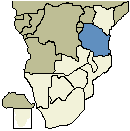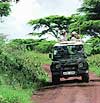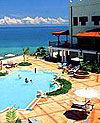Tanzania
Wildlife in abundance
Quick Reference

View detailed MapCurrency: 1 Tanzanian Shilling = 100 cents
Capital: Dodoma
Time: GMT +3
Main Lanuage: English and Swahili
Climate: Tropical region. Coast is warm and humid. Central regions warm and dry.
Electricity: 230 volts, 50Hz. Square or round three-pin plugs are used.

Safari Tours

Accommodation
Within Tanzania there is a variety of wildlife all surviving in a range of habitats which varies from the eternal snow of Mount Kilimanjaro to the tropical forests of the western regions, the plains of Serengeti, the stark volcanic landscapes, the wide savannahs of the Rift Valley and the balmy beaches of the long coastline and the adjacent islands.
Alongside these features are the diverse cultures of 120 ethnic groups, their languages, history and their artistic creations often played out in spectacular rituals and joyous music.
Mount Kilimanjaro, the view from the peak is incomparable. The climb presents an ever-changing series of natural environments from tropical rainforests to an eerie world of ice and snow.
Zanzibar. A tropical paradise surrounded by endless beaches.
Declared a World Heritage Site, the Ngorongoro Crater , rich in wildlife and the homeland of the Masai people.
The Serengeti National Park contains 35 major species of plains animals – including Africa’s Big 5: elephant, rhino, buffalo, lion and leopard, in staggering numbers- as well as some 500 different types of bird. Even the lesser species impress by the sheer size of their population, like the 1.5 million wildebeest that make a 1000km migration circuit of this region every year.
Tanzania, an unparalleled one-quarter of its surface area has been set aside for conservation purposes, harbouring an estimated 20 percent of Africa's large mammal population. The visitor is offered a safari destination without peer.
Currency
1 Tanzanian Shilling = 100 cents. The tourism industry prices everything in US Dollars and they are the preferred unit of currency. Major currencies can be exchanged in the larger towns. Foreign exchange bureaux in the main towns, usually offer a better rate of exchange than the banks, on Travelers cheques. ATMs are available in major cities only. Major lodges, some hotels and travel agents in urban areas accept credit cards, but these should not be relied on and can incur a 10% surcharge.
Health
Travelers are advised to take medical advice at least three weeks before leaving for Tanzania. Most visitors will need vaccinations for hepatitis A, typhoid, yellow fever and polio. Those arriving from an infected country must hold a yellow fever vaccination certificate. There is a risk of malaria all year and most doctors will recommend medication. Sleeping sickness is a risk in the game parks and visitors should avoid bites by tsetse flies. HIV/Aids is a serious risk. Cholera outbreaks are common throughout the country and visitors are advised to drink bottled or sterilised water only. Medical services are available in Dar-es-Salaam and other main towns, but facilities and supplies are limited; visitors with particular requirements should take their own medicines. Comprehensive medical insurance is advised.
Language
Kiswahili and English are the official languages. Several indigenous languages are also spoken.
Tipping
Waiters in the better restaurants should be tipped around 10%. Guides, porters and cooks in the wildlife parks and on safari trips expect tips. The amount is discretionary according to standard of service and the number in your party.
Geography and Climate
Tanzania has a tropical equatorial climate, which tends to make the country hot throughout the year, with more humidity on the coast and drier regions in the central plateau.
In the north of the country, there are two separate wet seasons, the longest being from March to May, and the shorter from November to December. The rest of the country experiences only one wet season, from November to May. Heavy rains can mean that road access becomes more limited, and most travel to Tanzania takes place in January and February, when the weather is hot and dry.
January to March is the best time to visit the magnificent Serengeti, when most grazers give birth and there are lots of lion on the prowl, and visitors can also witness the incredible spectacle of the annual wildebeest migration to and from Kenya that occurs at the beginning of the dry season and again with the first rains - usually at the beginning of June and then again in mid-November.
Religion
Visitors to Zanzibar should be aware that it is a predominantly Muslim area and a modest dress code, especially for women, should be respected when away from the beach and in public places.
Entry Requirements
All visitors entering Tanzania require a visa. Visitors may obtain a visa on arrival at Dar-es-Salaam or Zanzibar airports for US$50, payable in cash. All visitors also require proof of sufficient funds and should hold documentation for their return or onward journey. Passports should be valid for at least six months from date of entry. Those arriving from an infected country must hold a yellow fever vaccination certificate.
Internal Transport
Travel within the country can be conducted by road on good tar surfaces between major centres. For acccess to wilderness areas. air charter flights are the most convenient, or, in the case of very remote sites, 4X4 vehicles.




